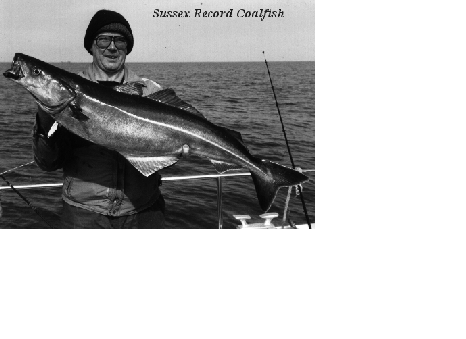
CATCHUP SEA CHARTER
SPECIES OF FISH THAT ARE CAUGHT OVER OUR CHANNEL WRECKS ON BOARD "CATCHUP III"
COALFISH : Deep water wreck predator, caught mainly between January and April, size from 6lb to 25lbs

Huge Coalfish can sometimes be taken on the deep water wrecks whilst redgilling for Pollack. These fish are renowned for fast crashing dives once hooked and are one of the hardest fighting fish in British waters, especially when 20lb plus specimens are hooked. A beautifull streamlined fish with an almost black back and distinctive pure white lateral stripe along its flank.
Tackle Required: 20lb to 30lb class rods to 25lb nylon main line.
Large redgills or pirks retrieved fast and high over the wrecks.
LING : Caught on the wrecks from March to September, a real scavenger fish. average size: 20lb to 28lb
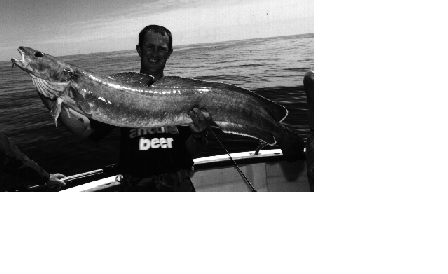
A popular fish from the wrecks during the summer season, easy to catch with mainly fresh whole fish baits to large 6/0 to 8/0 hooks, fished hard on the bottom around the wreck. They are caught either at Anchor or whilst dragging baits on the drift, especially around slack tidal periods. These fish have extremely sharp teeth and should be handled with care when extracting the hook.
Tackle Required: 30lb class boat rod to 35lb nylon main line
COD : Britains most popular fish, caught all year round, but caught in large numbers during May to September
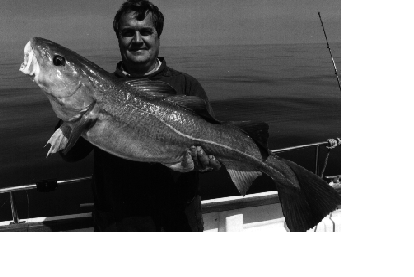 ...Huge
lunker Cod are probrably the
main quarry of the European deep sea angler. The fish grow
extremely fast and can be taken up to 50lbs, but the average is
normally 8lbs to 15lbs with a few 20lb plus specimens early and
late season. Cod are taken on all methods over the wrecks,
redgilling, pirking and baits like Squid and Cuttlefish
...Huge
lunker Cod are probrably the
main quarry of the European deep sea angler. The fish grow
extremely fast and can be taken up to 50lbs, but the average is
normally 8lbs to 15lbs with a few 20lb plus specimens early and
late season. Cod are taken on all methods over the wrecks,
redgilling, pirking and baits like Squid and Cuttlefish
Tackle Required: 20lb / 50lb class tackle, dependant on method
Jan / April: mainly taken on bait. May / Sept: Lures. Oct/Dec: Bait
BLACK BREAM : The hardest fighting small fish in british waters, average size on the wrecks 2lb to 4lb
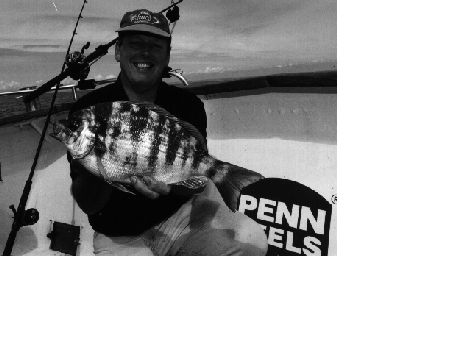
A great favorite with all anglers, not only hard fighting but probably the best eating fish in Channel waters. During July, the Bream move out onto the deep water wrecks after spawning, and can be taken on ultra light tackle fished hard on the bottom whilst at anchor uptide of the wreck. Small mouths mean size 1. hooks fished paternoster style with 2 or 3 small booms. Fresh Squid, Cuttlefish and Mackerel cut into tiny strips works best. A super fish!
Tackle: 12lb class rods to 15lb main line/ braid. size 2 to 1/0 hooks. 3 boom paternoster, baited mackerel feathers or flowing trace with single hook for the bigger fish. size: 2lb to 6lb
POLLACK : Deep water wreck favorite from January to May. Very hard diving fish average size 15lbs to 24lbs
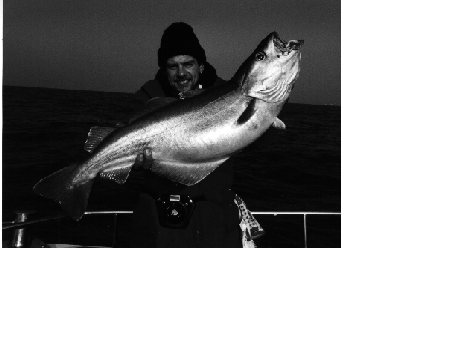
Pollack are a huge shoal fish that frequent the wrecks early season from Jan to May, attracted by the shoals of sprat and the tide runs around the debris, they are voracious feeders and are caught off bottom chasing artificial lures like Redgills and jellyworms fished on long 15ft to 20ft flowing traces, retrieved up fast on light tackle. The first dive when hooked can smash heavy nylon trace line easily for the unprepared. Average sizes of Pollack off of Sussex are the biggest in the Channel region with numerous specimens over 20lb taken daily.
Tackle: Light 12lb to 20lb class rods/ uptide rods to 25lb main
BASS : Often called the King of the Sea, A Real sportfish full of fight and hard to catch. Average size: 8lb to 13lb
Silver scaled beautiful scrappers, taken on various methods. Early season from April to June the fish come to Redgills fished drifting over the inshore wrecks, then from July to October the fish prefer a live bait such as joey mackerel or live sandeel. A pure predator that takes many years to reach maturity. a 10lb bass is in the region of 20 years old.
Tackle: uptide rods, 15lb clear mono main line, 30lb clear mono flowing trace to mustad 4/0 or to a 6/0 ( No.79515)
Handle with care: sharp razor like gill covers and spikes on all fins.
TURBOT: The largest flatfish taken in channel waters, average size: 15lbs to 25lbs. only caught in small numbers!
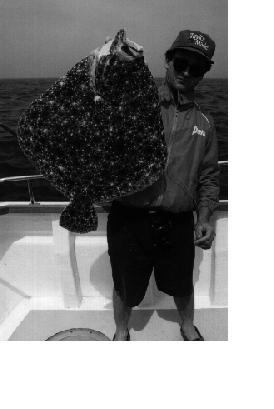
Turbot are a most sought after fish that frequent the tidal scours around the wreck on the seabed. Another pure predator that lays in wait, normally on the side of the bank. Superb camoflage enables this huge flatty to be a ruthless snatcher of any small fish passing in front of its mouth. Although Turbot are present in large numbers throughout the Channel area, they are what is termed a lucky fish, meaning a fish that no matter how hard you try to catch it, normally appears out of the blue when least expected. Turbot normally run in pairs, Male & Female, and sometimes they will either both be caught at once or one will follow the hooked mate up to the surface. Most of the larger Turbot between 20lb to 30lb caught around the wrecks are taken on a drifted or anchored joey mackerel bait intended for Ling or Conger. Turbot are sometimes confused with Brill, another similar flatty, but a Turbot can always be recognised by running your hand over its back, feeling small lumps under the skin, which a Brill does not have.
Tackle required: Around wrecks a flowing baited trace works well.
CONGER EEL: The biggest of all Wreck dwellers. Sizes caught average 40lb to 60lb, with some up to 100lbs +
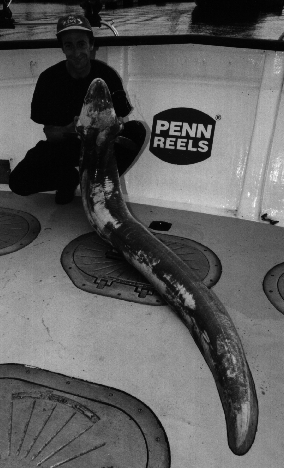
Conger Eels are present in huge numbers on most mid channel wrecks off of the Sussex shores, with average sizes being taken, well over the 40lb qualifying weight required to become a member of the exclusive: B.C.C. (British Conger Club), probably the biggest club dedicated to one species of European sea fish, with a strong following and an extensive collection of superb trophies available to be won by members each season. The Conger rod & line caught record stands at a massive 133lbs, but Conger eels have been taken commercially to nearly 200lbs and could possibly grow much bigger. The fight from a conger tests all tackle to the limit, especially with fish of 60lbs plus, and with the eels fast reflex once hooked to get back into the debris of a shipwreck before you can blink, many potential record breakers never see the light of day. The favoured method to take big Conger is to fish large baits such as whole Mackerel flapper, Pouting flapper, or Cuttlefish hard on the seabed directly uptide and as near to the wreck as possible, where big eels will be patrolling and pick up the scent of fresh bait. The bite can be either sensitive with small knocks on the rod tip, or without any warning, a surging run, pulling rod and unwitting angler close to the water hanging on for dear life. It must be the fight that attracts so many anglers out on the boat after eels, as they are extremely easy to catch when feeding, and when your bait is in the right area by the wreck.
Tackle Requirements: Heavy boat rod of 50lb to 80lb Test, Minimum Penn 4/0 High speed size reel with minimum 40lb nylon main line, 200lb nylon trace line crimped to a 10/0 forged hook, quality berkely swivels and perfect knots!
ALL OF THE ABOVE PICTURED FISH WERE CAUGHT ON BOARD CATCHUPIII
MUCH MORE DETAILED INFORMATION ON ALL OF THE ABOVE, SEE OUR PAGE TITLED: